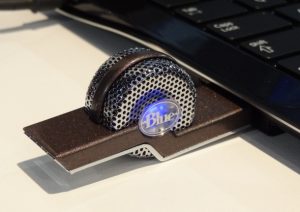Blue Tiki Review
 For such a small, inexpensive USB mic Blue makes lofty claims about the Tiki. In Intelligent Speech Mode it minimizes background noise. In Natural Recording Mode it balances levels from various sources such as vocals and acoustic guitar.
For such a small, inexpensive USB mic Blue makes lofty claims about the Tiki. In Intelligent Speech Mode it minimizes background noise. In Natural Recording Mode it balances levels from various sources such as vocals and acoustic guitar.
While this seems like godsend on paper, anyone who‘s applied noise gates and various filters to accentuate sounds is better tuned to the reality. When you gain one advantage via heavy tinkering you usually do it at the cost of another.
I found the audio quality in Intelligent Speech Mode to be below average due to internal DSP processing which rendered it dull and muffled. While this mode is designed for use with Dragon NaturallySpeaking or Skype, it ironically crippled speech recognition capabilities.
Natural Recording Mode faired better however the processing to make various instruments equal in volume wasn’t pronounced enough to place this above solutions such as Samson’s excellent Go Mic, which I reviewed here. Besides, most people are picking this up for its Intelligent Speech Mode.


One reason it can’t see serious podcasters or musicians using this is due to the awkward mic placement. Granted condenser microphones are adept at picking up distant noises but it’s awfully low to be speaking or singing into. This lowers proximity effect so the deeper frequencies in the voice won’t be as pronounced.
Another fatal flaw is the way the Tiki plugs into the USB input. The USB connection is oversized, putting unnecessary stress on the input of Apple laptops particularly. The convenience of doing away with cables that run to the device is clever on paper but again real-world application isn’t so hot. If you value your hardware you’ll be using a USB extension cable and that defeats the purpose of the design.
Despite the gripes if you want to record rough music AND use Skype and don’t have much money to spend the Tiki is a decent solution as it’s a jack-of-all-trades. Still, the gimmick-free Go Mic is a better bet.
 Shure has taken a much different approach to
Shure has taken a much different approach to 

 I’ve often recommended the
I’ve often recommended the 


